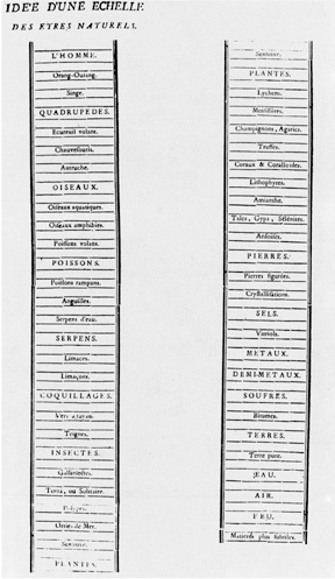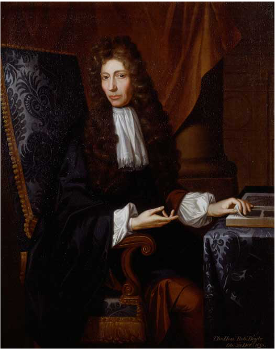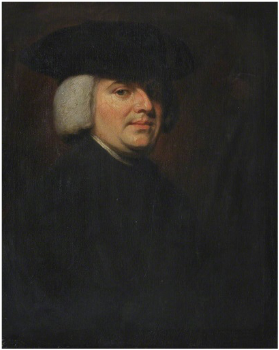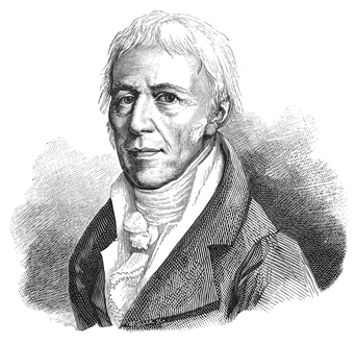Friedel Weinert
The discovery of deep time—the realization that the age of the Earth is much greater than hitherto assumed and that the cosmos has an evolutionary history—had profound implications, since it situated many aspects of human existence in a historical context. This process is known as temporalization. Society, geology, the universe acquired a history, and so did life itself. It ultimately emerged in Darwin’s evolutionary theory, but the history of organic life had been the subject of intense discussions for centuries. Although Charles Darwin’s (1809–1882) work was original, he had forerunners. One of the oldest views, reaching back to the Greeks, was the Great Chain of Being. The Enlightenment, in the wake of the Scientific Revolution (1543–1687), modified this ancient view and added design arguments to the thinking about organic life, its origin, and its purpose.
Before Darwin, many scholars recognized the diversity of species and their adaptation to their environments. The bone of contention was the mechanism of evolution, a question which Darwin finally answered with his theory of natural selection. But even if evolution was recognized, there was still a debate about the mode of existence of species: were species fixed or variable? Darwin threw some light on this debate in his historical sketch, which opens the fifth edition of On the Origin of Species by Means of Natural Selection, or the Preservation of Favoured Races in the Struggle for Life (1869). Darwin wrote:
Until recently the great majority of naturalists believed that species were immutable productions, and had been separately created. This view has been ably maintained by many authors.[1]
Amongst them were the French naturalist Georges Cuvier (1769–1832) and the Swedish botanist and zoologist Carl Linnaeus (1707–1778). They saw species as fixed populations, which were only subject to creation and extinction. But Darwin went on to consider the views of thirty-four nineteenth-century authors who considered species to be variable:
Some few naturalists, on the other hand, have believed that species undergo modification, and that the existing forms of life are the descendants by true generation of pre-existing forms.[2]
Amongst them were the French naturalists Étienne Geoffroy Saint-Hilaire (1772–1844) and Jean-Baptiste Lamarck (1744–1829). Geoffroy believed in the transmutation of species due to environmental causes. Lamarck is notable because he combined design and evolution to build his theory of progressive or linear evolution (or transmutation), which to a certain extent can be regarded as a forerunner to Darwin’s theory of branching evolution.[3]The slow evolution of biology must be seen against the background of the rapid progress of the physical sciences, which culminated in Newton’s publication of Philosophiae Naturalis Principia Mathematica(1687), which perfected the quantitative approach to nature.
The Great Chain of Being

The Great Chain of Being had been the dominant concept of organic nature since the Greeks: organic creation was depicted as a chain of being, the links of which consisted of all created lifeforms (fig. 1). It stretches from the humblest and crudest types right up the graded ladder of perfection to the highest forms—God and the angels. The series was perfectly continuous and harmonious, without chasms or gaps, and the forms that made it up were thought to blend insensibly into one another.[4]In this hierarchical order, humans occupy an intermediate position. They stand between the animal world of imperfection and the godly world of perfection, since they are both members of the organic and intellectual realms. Three principles underlie this conception: the principles of plenitude, continuity, and unilinear gradation. The principle of plenitude indicates that the world is full; everything which is possible also exists in actuality. This principle stands in strong contrast to evolutionary thinking. The principle of continuity indicates that there are no gaps in the chain of being and species blend insensibly into one another. The principle of unilinear gradation indicates the hierarchical order from the humblest creatures to the highest possible life form. Because the chain of being stretches from the lowest to the highest form of creation, it is a scale of perfection.[5]
Historically, the Great Chain of Being was interpreted in two different ways: either as a static preexisting chain of organic life or as an unfolding ladder of ascent. The static scheme left no room for evolution and no room for development. It was the ancient scheme, which is associated with the fixity of species. In the eighteenth century the fixity of species gave way to their variability. As new evidence for the transmutation of species accumulated, the need arose for a new, amended vision. The Great Chain of Being had to be temporalized, as the German philosopher Gottfried Wilhelm Leibniz (1646–1716) clearly stated:
Further, we realize that there is a perpetual and most free progress of the whole universe towards a consummation of the universal beauty and perfection of the works of God, so that it is always advancing toward a greater development.[6]
Naturalists, like Lamarck, transformed the chain of being into a ladder of ascent, but it retained some of its essential features. They believed that the universe evolves toward perfection; its progress is purposeful and follows a divine plan; and the Chain is no longer static, but it still grows and strives toward a goal, as Lamarck claimed.[7] Purposeful design places each species on their respective rung of the ladder, which provides the overall pattern. With the emergence of Darwinism, both finality and perfection finally disappeared.
Design Arguments

Design arguments aim to show that the order and regularity in the natural world are not due to random processes, but instead point to the existence of an intelligent designer (i.e., God). Robert Boyle (1627–1691) is a famous scientist who discovered Boyle’s law (fig. 2). Boyle was a devout Anglican and sought to show that natural philosophy could prove the existence of God. He wished to counter the Epicurean view that the beauty and symmetry of nature were the result of pure chance. In 1688 he published an extended proof of design in his book A Disquisition about the Final Causes of Natural Things. Boyle first looked at the argument for design from the point of view of inanimate objects. He noted that even so complex an object as a clock cannot match the complexity of animate objects in the biological world:
There is more of admirable Contrivance in a Mans Muscles, than in … the Celestial Orbs; and that the Eye of a Fly is … a more curious piece of Workmanship, than the Body of the Sun.[8]
The complexity and design of plants and animals was so intricate that an inference to a designer was justified, and it was obvious to Boyle that a divine engineer had created eyes to provide its lucky bearer with vision. It would be the height of irrationality to infer from the beauty and perfection of nature that pure chance had been the author.

A bit over a century later, Archdeacon William Paley (1743–1805) published his Natural Theology, or Evidences of the Existence and Attributes of the Deity, collected from the Appearances of Nature (1802) (fig. 3). The book presents the famous “watchmaker” argument: from the existence of a watch we infer a watchmaker; by analogy, we ought to infer a designer God from the order of nature. This design paradigm infers from the seeming order and perfection in nature to a divinely gifted engineer. Proponents of design arguments usually dismissed the Epicurean view of pure chance as highly implausible because it contradicted their sensory experiences, which seemed to tell them that the order and symmetry in the organic world must be the work of an intelligent creator. The organic world provided much more concrete evidence of divine artwork, and Boyle conceded that pure chance might have made stones and metals, but not vegetables and animals:
There is incomparably more Art expressed in the structure of a Doggs foot, then in that of the famous Clock at Strasburg.[9]
In Paley’s work we find a similar preference for biology to establish the design argument. It is true, wrote Paley, that a clock reveals a considerable amount of design. But the organic world offers much more striking instances of design. We discover so much beauty, order and regularity, that only an intelligent designer could have created the natural world.
There cannot be design without a designer; contrivance without a contriver, order without choice.[10]
With so much attention lavished on plants and animals, each species seemed to be purposefully crafted. Design arguments emphasized the inclinations of humans to read into organic nature a creator’s intention. Paley’s Natural Theology had the task of demonstrating “the final intention of the creator in respect to each structure.”[11]And then Lamarck came along and combined the ladder of ascent with design and proposed a now-discredited mechanism for his theory of organic progression.
Jean-Baptiste Lamarck
Lamarck made progressive evolution a central pillar of his theory; he thought that the evolution of the Ladder of Existence followed some preset aim (fig. 4). The telos, or aim, is to produce humans. Nature evolves from simpler to more complex organisms with the aim of bringing forth the most perfect being of them all: Homo sapiens. Following this approach, Lamarck worked out a way of temporalizing the Great Chain of Being. In doing so, he abandoned the idea of the fixity of species and the theory of special creations. The immutability of species had been a core element of many naturalist schemes at that time, but according to Lamarck, species evolve. He even proposed a mechanism by which evolution progresses: the inheritance of acquired characteristics, also known as soft inheritance. This theory claims that the characteristics that organisms acquire during their lifetimes can be passed on to the next generation. For instance, giraffes stretch their necks to reach the juicy leaves of tall trees; their necks grow longer, and the giraffes pass this elongated neck on to the next generation of giraffes. Cuvier rejected Lamarck’s evolutionism and Darwin would later ridicule this idea of soft inheritance. But it is to Lamarck’s credit that he taught the non-fixity of species, which later would become a central pillar of Darwin’s theory of evolution.

Apart from the mutability of species, one further element of Lamarck’s theory of progressive evolution lived on and would cause Darwin serious difficulties. Lamarck was a staunch materialist, but materialism has many connotations. In the present-day context it expresses the belief that all the phenomena of organic life can be explained by appeal to physical causes. This includes the higher mental capacities of human beings. The doctrine had a long tradition in France with Paul-Henri Dietrich, Baron d’Holbach (1723–1789) and Claude-Adrien Helvétius (1715–1771). It led to Julien Offroy de La Mettrie’s (1709–1751) image of man-machine (l’homme machine). For the materialist, mental faculties and consciousness are nothing but expressions of brain states. Darwin, too, was a materialist, since he regarded the theory of natural selection as an empirical, testable theory. He, too, aimed to explain the higher mental faculties in humans as subject to a materialist explanation.
The State of Biology
When we consider the state of biology during this period it is obvious that ideas about species, including their origin, state, and possible development, were in a state of flux. By 1859, when Darwin published the first edition of his Origin of Species, astronomy and physics were mature sciences. They rested on the firm foundation of Newtonian mechanics, that is, the three laws of motion and the law of gravitation. Heliocentrism—the idea that the sun was at the center of the universe—was the established view of the planetary system. The discovery of a new planet , Neptune, in 1846, had shown the explanatory and predictive power of the Newtonian paradigm. The science of thermodynamics was also making rapid advances during the middle of the nineteenth century. The biological sciences, by contrast, lacked an agreed-upon paradigm and, before Darwin, could offer no convincing explanatory mechanism for the diversity of species. Any evidence in favor of evolutionary descent was only slowly emerging. When evidence became available it showed that at least some of the previous assumptions, like the fixity of species or the late emergence of humankind, could not be upheld.
In the fifty years between the publication of Lamarck’s Philosophie Zoologique in 1809 and the publication of Darwin’s Origin of Species in 1859, new discoveries had emerged in diverse fields. In geology, for instance, the age of the Earth was gradually being extended from the miserly 6,000 years of the Bible to Kant’s millions of years of cosmic evolution. It was discovered that the rock layers and their fossils contained a hidden arrow of time. The deeper the rock strata, the older the fossils and the rocks. In paleontology, the study of prehistoric life, fossil finds added to the temporalization of the Earth. Fossils of extinct animals, of unknown lifeforms, revealed the fauna of ancient times (fig.5). The discovery of an extinct creature (the Archaeopteryx in 1861), a transitional form between dinosaurs and birds, became the subject of intense discussions. Human fossil records were found among fossils of extinct animals, including the cave bear, mammoth, and early horses (fig. 6). Also found were tools and weapons made of flint stone. This suggested that hominoid creatures inhabited regions of Europe that were once home to now extinct animals. These discoveries prepared the way for Darwin’s theory of evolution because they provided evidence of the evolution of species and the antiquity of the human race. What was missing from biology was a credible theory that systematized these findings, such as Newton had done for the physical sciences.
However, biology made a giant step toward an established paradigm when Darwin published his Origin of Species because his theory of evolution contained a testable mechanism—natural selection—that can account for the diversity and mutability of species.


Further Reading:
Boyle, Robert. A Disquisition about the Final Causes of Natural Things. London: John Taylor, 1688.
Bowler, Peter J. Evolution: The History of an Idea. Berkeley: Berkeley University Press, 2004.
Darwin, Charles. On the Origin of Species by Means of Natural Selection, or the Preservation of Favoured Races in the Struggle for Life. London: John Murray, 1859. See online Darwin.
Eiseley, Loren. Darwin’s Century: Evolution and the Men Who Discovered It. London: Gollancz, 1959.
Gillispie, Charles Coulston. “Lamarck and Darwin in the History of Science,” American Scientist 46, no. 4 (December 1958), xlvi, 388–409.
Gillispie, Charles Coulston. Genesis and Geology: The Impact of Scientific Discoveries upon Religious Beliefs in the Decades Before Darwin. New York: Harper & Row, 1959.
Gould, Stephen Jay. The Structure of Evolutionary Theory. Cambridge, MA: Belknap Press, 2002.
Greene, John C. “The Kuhnian Paradigm and the Darwinian Revolution in Natural History,” in Gary Gutting, ed. Paradigms and Revolutions: Appraisals and Applications of Thomas Kuhn’s Philosophy of Science. Notre Dame: University of Notre Dame, 1980, 297–32.
Larson, Edward J. Evolution: The Remarkable History of a Scientific Theory. New York: Modern Library, 2006.
Leibniz, Gottfried Wilhelm. “On the Ultimate Origination of Things,” in Leibniz: Philosophical Writings, ed. G. H. R. Parkinson, trans. Mary Morris and G. H. R. Parkinson. London: Dent, 1973, 136–44.
Lovejoy, Arthur O. The Great Chain of Being: A Study of the History of an Idea. Cambridge, MA: Harvard University Press, 1936.
Rolle, Friedrich. Der Mensch: seine Abstammung und Gesittung im Lichte der Darwin’schen Lehre, 2nd. ed. Prag: Verlag von Friedrich Tempsky, 1870.
Ruse, Michael. Darwin and Design: Does Evolution Have a Purpose? Cambridge, MA: Harvard University Press, 2003.
Weinert, Friedel. Copernicus, Darwin & Freud: Revolutions in the History and Philosophy of Science. Chichester, UK: Wiley-Blackwell, 2009.
Endnotes
[1]. This quote is taken from the fifth edition of Charles Darwin, On the Origin of Species by Means of Natural Selection, or the Preservation of Favoured Races in the Struggle for Life (London: John Murray, 1869), xv.
[2]. Darwin, On the Origin of Species (1869), xv.
[3]. See Peter J. Bowler, Evolution: The History of an Idea (Berkeley: Berkeley University Press, 2004) and Edward J. Larson, Evolution: The Remarkable History of a Scientific Theory (New York: Modern Library, 2006) for more detail.
[4]. Charles Coulston Gillispie, Genesis and Geology: The Impact of Scientific Discoveries upon Religious Beliefs in the Decades Before Darwin (New York: Harper & Row, 1959), 17–20; and Arthur O. Lovejoy, The Great Chain of Being: A Study of the History of an Idea (Cambridge, MA: Harvard University Press, 1936), 59.
[5]. Lovejoy, The Great Chain of Being, 52–55.
[6]. Gottfried Wilhelm Leibniz, “On the Ultimate Origination of Things,” in Leibniz: Philosophical Writings, ed. G. H. R. Parkinson, trans. Mary Morris and G. H. R. Parkinson (London: Dent, 1973), 144; Lovejoy, The Great Chain of Being, 244–45.
[7]. Compare this with Michael Ruse, Darwin and Design: Does Evolution Have a Purpose? (Cambridge, MA: Harvard University Press, 2003).
[8]. Robert Boyle, A Disquisition about the Final Causes of Natural Things (London: John Taylor, 1688), 43–44.
[9]. Boyle, A Disquisition about the Final Causes of Natural Things, 47.
[10]. Quoted in Charles Coulston Gillispie, Genesis and Geology (New York: Harper & Row, 1959), 36.
[11]. Loren Eiseley, Darwin’s Century: Evolution and the Men Who Discovered It (London: Gollancz, 1959), 178.

